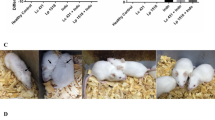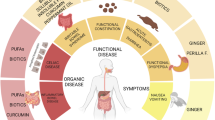Abstract
Objective: To determine whether recombinant human lactoferrin ingestion inhibits nonsteroidal antiinflammatory drugs (NSAID)-induced gastroenteropathy in vivo in healthy volunteers as a model for disorders associated with a rise in permeability of the stomach and the small intestine.
Design: A randomized crossover dietary intervention.
Subjects and interventions: In all, 15 healthy volunteers (age 23±1.4 y) were tested. A sucrose and a lactulose/rhamnose (L/R) permeability test was performed to assess gastroduodenal and small intestine permeability as indicator of NSAID-induced gastroenteropathy. All subjects consumed standardized meals for 2 days. On the second day at time=−24 h each subject ingested a drink containing 5 g recombinant human lactoferrin or placebo during breakfast. At t=−9 h, subjects ingested the same drink with 75 mg of the NSAID indomethacin and after an overnight fast at t=−1 h subjects consumed the drink and 50 mg indomethacin. After 1 h, at t=0, a permeability test was performed.
Results: Small intestine permeability after indomethacin and placebo was significantly higher (L/R ratio=0.036; 0.014–0.092, P<0.05) compared to the permeability observed after ingestion of indomethacin and lactoferrin (0.028; 0.015–0.056), whereas gastroduodenal permeability did not differ between the two interventions (P=0.3).
Conclusions: Oral recombinant human lactoferrin supplementation during a short-term indomethacin challenge reduced the NSAID-mediated increase in small intestinal permeability and hence may provide a nutritional tool in the treatment of hyperpermeability-associated disorders.
Sponsorship: Grant and human recombinant lactoferrin donated from Agennix Inc., Houston, TX.
This is a preview of subscription content, access via your institution
Access options
Subscribe to this journal
Receive 12 print issues and online access
$259.00 per year
only $21.58 per issue
Buy this article
- Purchase on Springer Link
- Instant access to full article PDF
Prices may be subject to local taxes which are calculated during checkout


Similar content being viewed by others
References
Aguila A, Herrera AG, Morrison D, Cosgrove B, Perojo A, Montesinos I, Perez J, Sierra G, Gemmell CG & Brock JH (2001): Bacteriostatic activity of human lactoferrin against Staphylococcus aureus is a function of its iron-binding properties and is not influenced by antibiotic resistance. FEMS Immunol. Med. Microbiol. 31, 145–152.
Baker EN, Anderson BF, Baker HM, Haridas M, Jameson GB, Norris GE, Rumball SV & Smith CA (1991): Structure, function and flexibility of human lactoferrin. Int. J. Biol. Macromol. 13, 122–129.
Baldwin DA, Jenny ER & Aisen P (1984): The effect of human serum transferrin and milk lactoferrin on hydroxyl radical formation from superoxide and hydrogen peroxide. J. Biol. Chem. 259, 13391–13394.
Bellamy W, Takase M, Yamauchi K, Wakabayashi H, Kawase K & Tomita M (1992): Identification of the bactericidal domain of lactoferrin. Biochim. Biophys. Acta 1121, 130–136.
Bjarnason I, Fehilly B, Smethurst P, Menzies IS & Levi AJ (1991): Importance of local versus systemic effects of nonsteroidal anti-inflammatory drugs in increasing small intestinal permeability in man. Gut 32, 275–277.
Bjarnason I, Hayllar J, MacPherson AJ & Russell AS (1993): Side effects of nonsteroidal anti-inflammatory drugs on the small and large intestine in humans. Gastroenterology 104, 1832–1847.
Bjarnason I, O'Morain C, Levi AJ & Peters TJ (1983): Absorption of 51chromium-labeled ethylenediaminetetraacetate in inflammatory bowel disease. Gastroenterology 85, 318–322.
Bjarnason I, Smethurst P, Fenn CG, Lee CE, Menzies IS & Levi AJ (1989): Misoprostol reduces indomethacin-induced changes in human small intestinal permeability. Digestive Dis. Sci. 34, 407–411.
Bjarnason I, Williams P, Smethurst P, Peters TJ & Levi AJ (1986): Effect of nonsteroidal anti-inflammatory drugs and prostaglandins on the permeability of the human small intestine. Gut 27, 1292–1297.
Britigan BE, Serody JS & Cohen MS (1994): The role of lactoferrin as an anti-inflammatory molecule. Adv. Exp. Med. Biol. 357, 143–156.
Brock J (1995): Lactoferrin: a multifunctional immunoregulatory protein? Immunol. Today 16, 417–419.
Carafoli E (1987): Intracellular calcium homeostasis. Annu. Rev. Biochem. 56, 395–433.
Crouch SP, Slater KJ & Fletcher J (1992): Regulation of cytokine release from mononuclear cells by the iron- binding protein lactoferrin. Blood 80, 235–240.
Crowe SE & Perdue MH (1992): Gastrointestinal food hypersensitivity: basic mechanisms of pathophysiology. Gastroenterology 103, 1075–1095.
Davidson LA & Lonnerdal B (1989): Fe-saturation and proteolysis of human lactoferrin: effect on brush-border receptor-mediated uptake of Fe and Mn. Am. J. Physiol. 257(Pt 1), G930–G934.
Davidson LA & Lonnerdal B (1986): Isolation and characterization of rhesus monkey milk lactoferrin. Pediatr. Res. 20, 197–201.
Davidson LA & Lonnerdal B (1988): Specific binding of lactoferrin to brush-border membrane: ontogeny and effect of glycan chain. Am. J. Physiol. 254(Pt 1), G580–G585.
Ferry DM, Butt TJ, Broom MF, Hunter J & Chadwick VS (1989): Bacterial chemotactic oligopeptides and the intestinal mucosal barrier. Gastroenterology 97, 61–67.
Gutteridge JM, Paterson SK, Segal AW & Halliwell B (1981): Inhibition of Lipid Peroxidation by the Iron-Binding Protein Lactoferrin. Biochem. J. 199, 259–261.
Hawkey CJ & Rampton DS (1985): Prostaglandins and the gastrointestinal mucosa: are they important in its function, disease, or treatment? Gastroenterology 89, 1162–1188.
Ikeda M, Nozaki A, Sugiyama K, Tanaka T, Naganuma A, Tanaka K, Sekihara H, Shimotohno K, Saito M & Kato N (2000): Characterization of antiviral activity of lactoferrin against hepatitis C virus infection in human cultured cells. Virus Res. 66, 51–63.
Isolauri E, Juntunen M, Wiren S, Vuorinen P & Koivula T (1989): Intestinal permeability changes in acute gastroenteritis: effects of clinical factors and nutritional management. J. Pediatr. Gastroenterol. Nutr. 8, 466–473.
Iyer S & Lonnerdal B (1993): Lactoferrin, lactoferrin receptors and iron metabolism. Eur. J. Clin. Nutr. 47, 232–241.
Kawakami H & Lonnerdal B (1991): Isolation and function of a receptor for human lactoferrin in human fetal intestinal brush-border membranes. Am. J. Physiol. 261(Pt 1), G841–G846.
Kuhara T, Iigo M, Itoh T, Ushida Y, Sekine K, Terada N, Okamura H & Tsuda H (2000): Orally administered lactoferrin exerts an antimetastatic effect and enhances production of IL-18 in the intestinal epithelium. Nutr. Cancer 38, 192–199.
Lambert GP, Broussard LJ, Mason BL, Mauermann WJ & Gisolfi CV (2001): Gastrointestinal permeability during exercise: effects of aspirin and energy-containing beverages. J. Appl. Physiol. 90, 2075–2080.
Legrand D, Mazurier J, Elass A, Rochard E, Vergoten G, Maes P, Montreuil J & Spik G (1992): Molecular interactions between human lactotransferrin and the phytohemagglutinin-activated human lymphocyte lactotransferrin receptor lie in two loop-containing regions of the N-terminal domain I of human lactotransferrin. Biochemistry 31, 9243–9251.
Levay PF & Viljoen M (1995): Lactoferrin: a general review. Haemotologica 80, 252–267.
May GR, Sutherland LR & Meddings JB (1993): Is small intestinal permeability really increased in relatives of patients with Crohn's disease? Gastroenterology 104, 1627–1632.
Mazurier J, Montreuil J & Spik G (1985): Visualization of lactotransferrin brush-border receptors by ligand-blotting. Biochim. Biophys. Acta 821, 453–460.
McAbee DD & Esbensen K (1991): Binding and endocytosis of apo- and holo-lactoferrin by isolated rat hepatocytes. J. Biol. Chem. 266(35), 23624–23631.
Meddings JB (1997): Review article: Intestinal permeability in Crohn's disease. Aliment Pharmacol. Ther. 11(Suppl 3), 47–53. (Discussion 53-6).
Meddings JB, Sutherland LR, Byles NI & Wallace JL (1993): Sucrose: a novel permeability marker for gastroduodenal disease. Gastroenterology 104, 1619–1626.
Miller MJ, Zhang XJ, Gu XA & Clark DA (1991): Acute intestinal injury induced by acetic acid and casein: prevention by intra-luminal misoprostol. Gastroenterology 101, 22–30.
Murphy ME, Kariwa H, Mizutani T, Yoshimatsu K, Arikawa J & Takashima I (2000): In vitro antiviral activity of lactoferrin and ribavirin upon hantavirus. Arch. Virol. 145, 1571–1582.
Nibbering PH, Ravensbergen E, Welling MM, van Berkel LA, van Berkel PH, Pauwels EK & Nuijens JH (2001): Human lactoferrin and peptides derived from its N terminus are highly effective against infections with antibiotic-resistant bacteria. Infect. Immun. 69, 1469–1476.
Nuijens JH, van Berkel PH & Schanbacher FL (1996): Structure and biological actions of lactoferrin. J. Mammary. Gland. Biol. Neo-plasia. 1, 285–295.
Playford RJ, MacDonald CE, Calnan DP, Floyd DN, Podas T, Johnson W, Wicks AC, Bashir O & Marchbank T (2001): Co-administration of the health food supplement, bovine colostrum, reduces the acute non-steroidal anti-inflammatory drug-induced increase in intestinal permeability. Clin. Sci. (London) 100, 627–633.
Rooyakkers DR, van Eijk HM & Deutz NE (1996): Simple and sensitive multi-sugar-probe gut permeability test by high-performance liquid chromatography with fluorescence labelling. J. Chromatogr. A 730, 99–105.
Shinoda I, Takase M, Fukuwatari Y, Shimamura S, Koller M & Konig W (1996): Effects of lactoferrin and lactoferricin on the release of interleukin 8 from human polymorphonuclear leukocytes. Biosci. Biotechnol. Biochem. 60, 521–523.
Smecuol E, Bai JC, Vazquez H, Kogan Z, Cabanne A, Niveloni S, Pedreira S, Boerr L, Maurino E & Meddings JB (1997): Gastrointestinal permeability in celiac disease. Gastroenterology 112, 1129–1136.
Soderholm JD & Perdue MH (2001): Stress and gastrointestinal tract. II. Stress and intestinal barrier function. Am. J. Physiol. Gastrointest. Liver. Physiol. 280, G7–G13.
Somasundaram S, Hayllar H, Rafi S, Wrigglesworth JM, Macpherson AJ & Bjarnason I (1995): The biochemical basis of nonsteroidal anti-inflammatory drug-induced damage to the gastrointestinal tract: a review and a hypothesis. Scand. J. Gastroenterol. 30, 289–299.
Somasundaram S, Rafi S, Hayllar J, Sigthorsson G, Jacob M, Price AB, Macpherson A, Mahmod T, Scott D, Wrigglesworth JM & Bjarnason I (1997): Mitochondrial damage: a possible mechanism of the ‘topical’ phase of NSAID induced injury to the rat intestine. Gut 41, 344–353.
Swart PJ, Kuipers EM, Smit C, Van Der Strate BW, Harmsen MC & Meijer DK (1998): Lactoferrin. Antiviral activity of lactoferrin. Adv. Exp. Med. Biol. 443, 205–213.
Troost FJ, Steijns J, Saris WH & Brummer RJ (2001): Gastric digestion of bovine lactoferrin in vivo in adults. J. Nutr. 131, 2101–2104.
van Nieuwenhoven MA, Geerling BJ, Deutz NE, Brouns F & Brummer R J (1999): The sensitivity of the lactulose/rhamnose gut permeability test. Eur. J. Clin. Invest. 29, 160–165.
Wallace JL (1993): Gastric ulceration: critical events at the neutrophil–endothelium interface. Can. J. Physiol. Pharmacol. 71, 98–102.
Wyatt J, Vogelsang H, Hubl W, Waldhoer T & Lochs H (1993): Intestinal permeability and the prediction of relapse in Crohn's disease. Lancet 341, 1437–1439.
Zagulski T, Jarzabek Z, Zagulska A & Zimecki M (1998): The main systemic, highly effective, and quickly acting antimicrobial mechanisms generated by lactoferrin in mammals in vivo. Activity in health and disease. Adv. Exp. Med. Biol. 443, 247–250.
Zimecki M, Spiegel K, Wlaszczyk A, Kubler A & Kruzel M L (1999): Lactoferrin increases the output of neutrophil precursors and attenuates the spontaneous production of TNF-alpha and IL-6 by peripheral blood cells. Arch. Immunol. Ther. Exp. 47, 113–118.
Zimecki M, Wlaszczyk A, Cheneau P, Brunel A S, Mazurier J, Spik G & Kubler A (1998): Immunoregulatory effects of a nutritional preparation containing bovine lactoferrin taken orally by healthy individuals. Arch. Immunol. Ther. Exp. 46, 231–240.
Acknowledgements
We are grateful to Dr. Fred Browns and Dr. Dominique Goovaer's (Cerestar, Belgium) for carrying out the sucrose analyses.
Author information
Authors and Affiliations
Corresponding author
Rights and permissions
About this article
Cite this article
Troost, F., Saris, W. & Brummer, RJ. Recombinant human lactoferrin ingestion attenuates indomethacin-induced enteropathy in vivo in healthy volunteers. Eur J Clin Nutr 57, 1579–1585 (2003). https://doi.org/10.1038/sj.ejcn.1601727
Received:
Revised:
Accepted:
Published:
Issue Date:
DOI: https://doi.org/10.1038/sj.ejcn.1601727
Keywords
This article is cited by
-
Intestinal barrier function in morbid obesity: results of a prospective study on the effect of sleeve gastrectomy
International Journal of Obesity (2020)
-
The effects of Lactobacillus plantarum on small intestinal barrier function and mucosal gene transcription; a randomized double-blind placebo controlled trial
Scientific Reports (2017)
-
Human Intestinal Barrier Function in Health and Disease
Clinical and Translational Gastroenterology (2016)
-
Intestinal permeability in the pathogenesis of NSAID-induced enteropathy
Journal of Gastroenterology (2009)
-
Effects of oral adenosine 5'-triphosphate and adenosine in enteric-coated capsules on indomethacin-induced permeability changes in the human small intestine: a randomized cross-over study
BMC Gastroenterology (2007)



